Page is loading ...

DCV517
Final Page size: A5 (148mm x 210mm)

B
Copyright
DeWALT
Dansk (oversat fra original brugsvejledning) 4
Deutsch (übersetzt von den originalanweisungen) 14
English (original instructions) 25
Español (traducido de las instrucciones originales) 35
Français (traduction de la notice d’instructions originale) 46
Italiano (tradotto dalle istruzioni originali) 57
Nederlands (vertaald vanuit de originele instructies) 68
Norsk (oversatt fra de originale instruksjonene) 79
Português (traduzido das instruções originais) 89
Suomi (käännetty alkuperäisestä käyttöohjeesta) 100
Svenska (översatt från de ursprungliga instruktionerna) 110
Türkçe (orijinal talimatlardan çevrilmiştir) 120
(μετάφραση από τις πρωτότυπες οδηγίες) 131
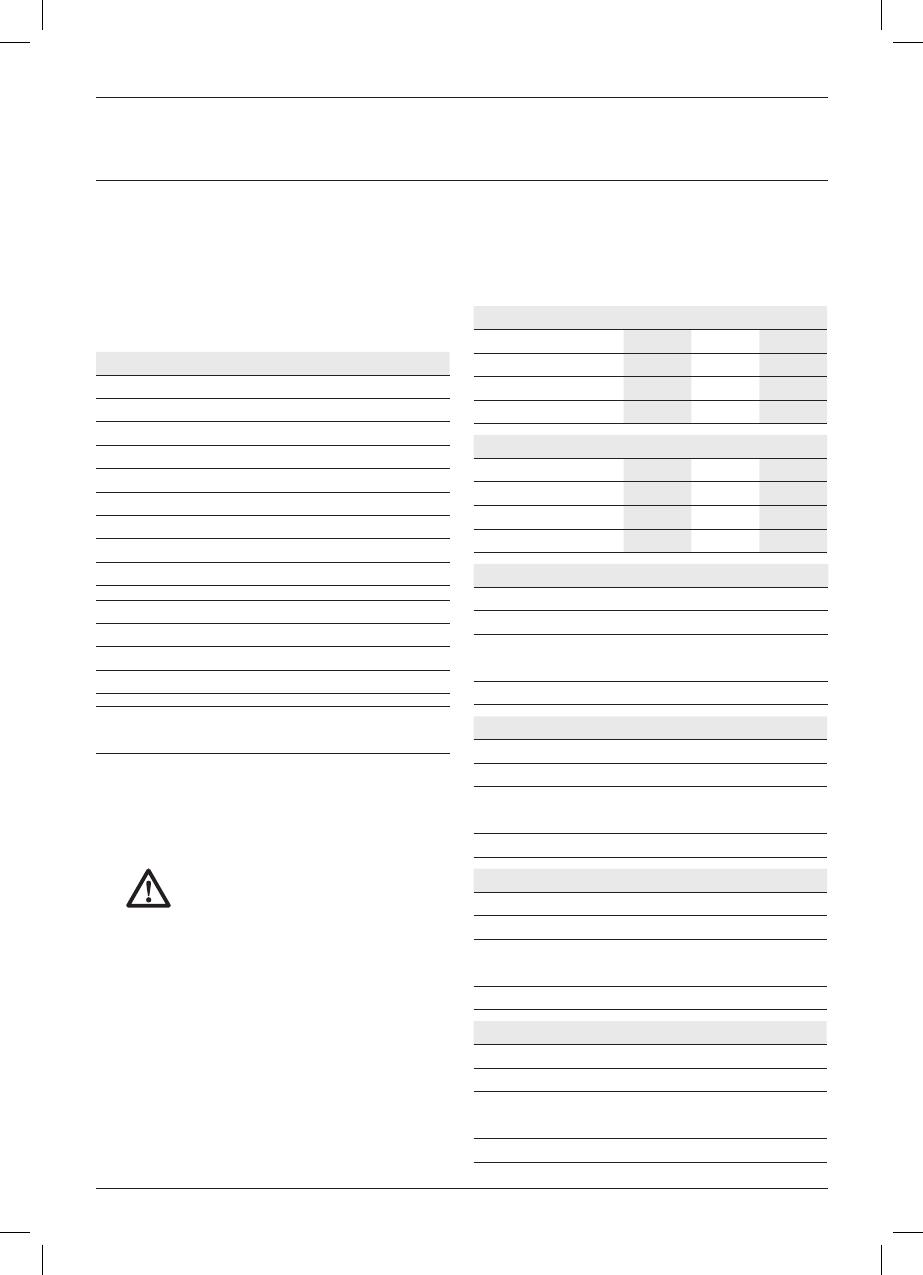
25
english
CORDLESS WET/DRY VACUUM CLEANER
DCV517
English (original instructions)
Congratulations!
You have chosen a
DeWALT
appliance. Years of
experience, thorough product development and
innovation make D
e
WALT one of the most reliable
partners for professional power toolusers.
Technical Data
DCV517
Type 1
Power source DC
Battery voltage V
DC
18
Power W 180
Tank volume l 1.9
Max. airflow l/s 15.9
Protection class IPX4
Hose nozzle diameter mm 32
Weight (without battery pack) kg 1.8
Noise values and vibration values (triax vector sum) according to EN60335
L
PA
(emission sound pressure level) dB(A) 76
L
WA
(sound power level) dB(A) 87
K
WA
(uncertainty for the given sound level) dB(A) 3
Vibration emission value a
h
= m/s
2
<2.5
Uncertainty K = m/s
2
1.5
The vibration emission level given in this information
sheet has been measured in accordance with a
standardised test given in EN 60335-2-69 and may
be used to compare one tool with another. It may
be used for a preliminary assessment ofexposure.
WARNING: The declared vibration
emission level represents the main
applications of the tool. However if the
tool is used for different applications,
with different accessories or poorly
maintained, the vibration emission may
differ. This may significantly increase
the exposure level over the total
workingperiod.
An estimation of the level of exposure to
vibration should also take into account
the times when the tool is switched off
or when it is running but not actually
doing the job. This may significantly
reduce the exposure level over the total
workingperiod.
Identify additional safety measures to
protect the operator from the effects of
vibration such as: maintain the tool and
the accessories, keep the hands warm,
organisation of workpatterns.
Battery pack DCB180 DCB181 DCB182
Battery type Li-Ion Li-Ion Li-Ion
Voltage V
DC
18 18 18
Capacity Ah 3.0 1.5 4.0
Weight kg 0.64 0.35 0.61
Battery pack DCB183/B DCB184/B DCB185
Battery type Li-Ion Li-Ion Li-Ion
Voltage V
DC
18 18 18
Capacity Ah 2.0 5.0 1.3
Weight kg 0.40/0.45 0.62/0.67 0.35
Charger DCB105
Mains voltage V
AC
230
Battery type 10.8/14.4/18 Li-Ion
Approx. charging time
of battery packs
min 25 (1.3 Ah) 30 (1.5 Ah) 40 (2.0 Ah)
55 (3.0 Ah) 70 (4.0 Ah) 90 (5.0 Ah)
Weight kg 0.49
Charger DCB107
Mains voltage V
AC
230
Battery type 10.8/14.4/18 Li-Ion
Approx. charging time
of battery packs
min 60 (1.3 Ah) 70 (1.5 Ah) 90 (2.0 Ah)
140 (3.0 Ah) 185 (4.0 Ah) 240 (5.0 Ah)
Weight kg 0.29
Charger DCB112
Mains voltage V
AC
230
Battery type 10.8/14.4/18 Li-Ion
Approx. charging time
of battery packs
min 40 (1.3 Ah) 45 (1.5 Ah) 60 (2.0 Ah)
90 (3.0 Ah) 120 (4.0 Ah) 150 (5.0 Ah)
Weight kg 0.36
Charger DCB113
Mains voltage V
AC
230
Battery type 10.8/14.4/18 Li-Ion
Approx. charging time
of battery packs
min 30 (1.3 Ah) 35 (1.5 Ah) 50 (2.0 Ah)
70 (3.0 Ah) 100 (4.0 Ah) 120 (5.0 Ah)
Weight kg 0.4
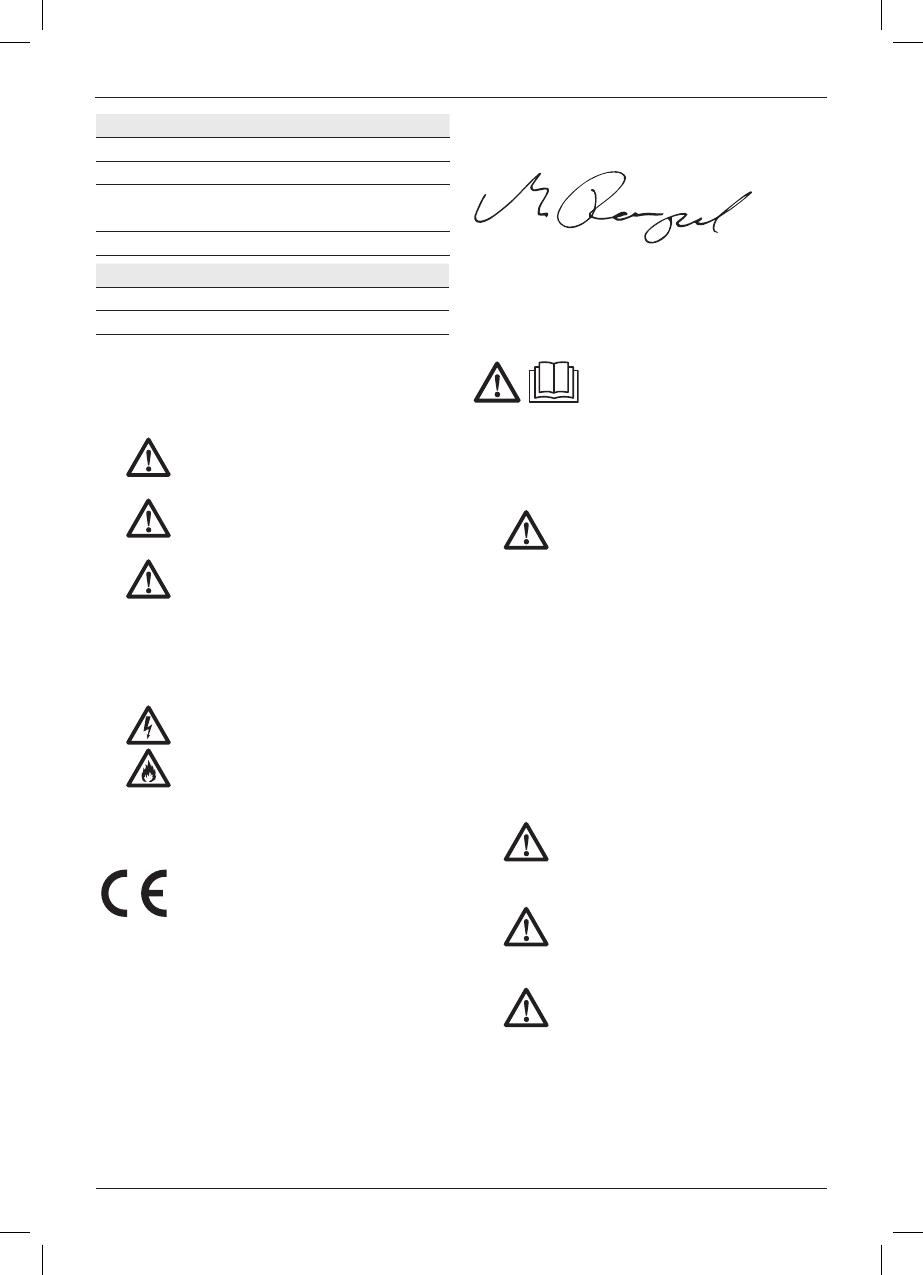
26
english
The undersigned is responsible for compilation of
the technical file and makes this declaration on
behalf of
DeWALT
.
Markus Rompel
Director Engineering
DeWALT
, Richard-Klinger-Straße 11,
D-65510, Idstein, Germany
18.12.2015
CAUTION: Read the
operating instruction
before using
theappliance.
Important Safety Instructions
WARNING! Read all
safety warnings and all
instructions. Failure to follow
the warnings and instructions
may result in electric shock,
fire and/or seriousinjury.
SAVE ALL WARNINGS AND
INSTRUCTIONS
FOR FUTURE REFERENCE
BEFORE USING THIS APPLIANCE, READ
AND FOLLOW ALLINSTRUCTIONS.
WARNING: Operators shall
be adequately instructed on
the use of theseappliances.
WARNING: To reduce the
risk of electric shock. Do not
expose to rain. Storeindoors.
WARNING: This appliance
is not suitable for picking up
hazardousdust.
• Before use, operators shall
be provided with information,
instruction and training for the
use of the appliance and the
Charger DCB115
Mains voltage V
AC
230
Battery type 10.8/14.4/18 Li-Ion
Approx. charging time
of battery packs
min 25 (1.3 Ah) 30 (1.5 Ah) 40 (2.0 Ah)
55 (3.0 Ah) 70 (4.0 Ah) 90 (5.0 Ah)
Weight kg 0.5
Fuses:
Europe 230V tools 10 Amperes. mains
U.K. & Ireland 230V tools 3 Amperes. in plugs
Definitions: Safety Guidelines
The definitions below describe the level of severity
for each signal word. Please read the manual and
pay attention to thesesymbols.
DANGER: Indicates an imminently
hazardous situation which, if not avoided,
will result in death or seriousinjury.
WARNING: Indicates a potentially
hazardous situation which, if not avoided,
could result in death or seriousinjury.
CAUTION: Indicates a potentially
hazardous situation which, if not
avoided, may result in minor or
moderateinjury.
NOTICE: Indicates a practice
not related to personal injury
which, if not avoided, may result in
propertydamage.
Denotes risk of electricshock.
Denotes risk offire.
EC-Declaration of Conformity
MACHINERY DIRECTIVE
CORDLESS WET/DRY VACUUM CLEANER
DCV517
DeWALT
declares that these products described
under Technical Data are in compliance with:
2006/42/EC, EN 60335-1:2012, EN 60335-2-
69:2012.
These products also comply with Directive
2004/108/EC (until 19.04.2016) and 2014/30/
EU (from 20.04.2016) and 2011/65/EU. For more
information, please contact
DeWALT
at the following
address or refer to the back of themanual.

27
english
• Keep hair, loose clothing, fingers,
and all body parts away from the
openings and movingparts.
• Turn off all controls before
unplugging appliance or
removing the batterypack.
• Use extra care when cleaning
onstairs.
• Do not use the appliance to pick
up flammable or combustible
liquids, such as gasoline, or use
in areas where flammable or
combustible liquids arepresent.
• Static shocks are possible in
dry areas or when the relative
humidity of the air is low. This
is only temporary and does not
affect the use of thevacuum.
• To avoid spontaneous
combustion, empty tank
contents after eachuse.
SAVE THESE INSTRUCTIONS
Additional Safety Rules
• Do not pick up anything that is burning or
smoking, such as cigarettes, matches or
hotashes.
• This tool is splashproof according to
protection class IPX4. Do not submerge the
tool inwater.
• Do not use to vacuum combustible explosive
materials, such as coal, grain or other finely
divided combustiblematerial.
• Do not use to vacuum hazardous, toxic or
carcinogenic materials, such as asbestos
orpesticide.
• Do not use vacuum without filters inplace.
• Some wood contains preservatives which
can be toxic. Take extra care to prevent
inhalation and skin contact when working
with these materials. Request and follow
any safety information available from your
materialsupplier.
• Do not use vacuum as a stepladder.
• Do not place heavy objects onvacuum.
substances for which it is to be
used, including the safe method
of removal and disposal of the
materialcollected.
• Operators should observe any
safety regulations appropriate to
the materials beinghandled.
• Do not leave the appliance
when it is connected to a power
source. Unplug it from outlet and
remove battery pack when not in
use and beforeservicing.
• This product is not intended
for use by persons (including
children) suffering from
diminished physical, sensory
or mental abilities; lack of
experience andknowledge.
• Children should be supervised to
ensure that they do not play with
theappliance.
• Use this appliance ONLY
as described in the
manual. Use only D
e
WALT
recommendedattachments.
• If the appliance is not working
correctly, or if it has been
dropped, damaged, left
outdoors, or dropped in water,
return it to a servicecentre.
• Do not handle the plug,
battery pack, or appliance with
wethands.
• Do not put any objects into the
openings of the appliance. Do
not use the appliance with any
opening blocked; keep free of
dust, lint, hair and anything else
that may reduce airflow.
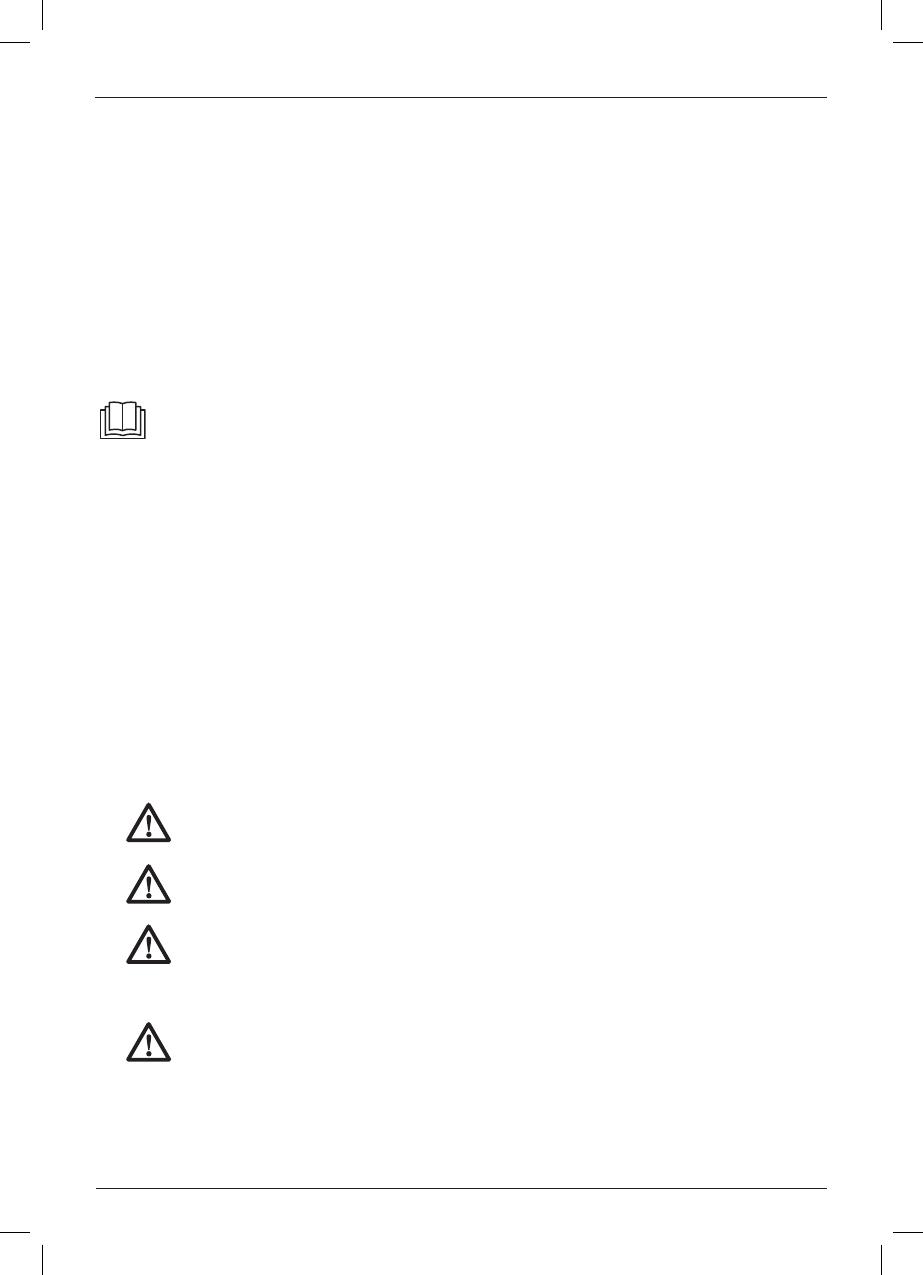
28
english
a conductive nature such as, but not
limited to, steel wool, aluminum foil or
any buildup of metallic particles should
be kept away from charger cavities.
Always unplug the charger from the
power supply when there is no battery
pack in the cavity. Unplug charger before
attempting toclean.
• Do not pull or carry this appliance by the
cord, use the cord as a handle, close a
door on the cord, or pull the cord around
sharp edges or corners. Do not run the
appliance over the cord. Keep cord away from
heatedsurfaces.
• DO NOT attempt to charge the battery
pack with any chargers other than the
ones in this manual. The charger and battery
pack are specifically designed to worktogether.
• These chargers are not intended for
any uses other than charging
DeWALT
rechargeable batteries. Any other uses
may result in risk of fire, electric shock
orelectrocution.
• Do not expose charger to rain orsnow.
• Pull by plug rather than cord when
disconnecting charger. This will reduce risk
ofdamage to electric plug andcord.
• Make sure that cord is located so that it
will not be stepped on, tripped over, or
otherwise subjected to damage orstress.
• Do not use an extension cord unless it
is absolutely necessary. Use of improper
extension cord could result in risk of fire, electric
shock, orelectrocution.
• Do not place any object on top of charger
or place the charger on a soft surface that
might block the ventilation slots and result
in excessive internal heat. Place the charger
in a position away from any heat source. The
charger is ventilated through slots in the top and
the bottom of thehousing.
• Do not operate charger with damaged cord
or plug—have them replacedimmediately.
• Do not operate charger if it has received
a sharp blow, been dropped, or otherwise
damaged in any way. Take it to an authorised
servicecentre.
• Do not disassemble charger; take it to an
authorised service centre when service or
repair is required. Incorrect reassembly may
result in a risk of electric shock, electrocution
orfire.
• In case of damaged power supply cord the
supply cord must be replaced immediately by
Residual Risks
In spite of the application of the relevant safety
regulations and the implementation of safety
devices, certain residual risks cannot be avoided.
These are:
– Risk of pinching or crushing offingers.
– Risk of inhaling fumes when working
withadhesives.
– Risk of inhaling hazardousdust.
– Risk of personal injury due to prolongeduse.
Markings on Tool
The following pictograms are shown on the tool:
Read instruction manual beforeuse.
DATE CODE POSITION (FIG. 2)
The date code (X), which also includes the year of
manufacture, is printed into thehousing.
Example:
2015 XX XX
Year of Manufacture
Important Safety Instructions for All
Battery Chargers
SAVE THESE INSTRUCTIONS: This manual
contains important safety and operating
instructions for compatible battery chargers (refer to
TechnicalData).
• Before using charger, read all instructions and
cautionary markings on charger, battery pack,
and product using batterypack.
WARNING: Shock hazard. Do not allow
any liquid to get inside charger. Electric
shock mayresult.
WARNING: We recommend the use of
a residual current device with a residual
current rating of 30mA orless.
CAUTION: Burn hazard. To reduce
the risk of injury, charge only
DeWALT
rechargeable batteries. Other types of
batteries may burst causing personal
injury anddamage.
CAUTION: Children should be
supervised to ensure that they do not
play with theappliance.
NOTICE: Under certain conditions,
with the charger plugged into the power
supply, the exposed charging contacts
inside the charger can be shorted by
foreign material. Foreign materials of
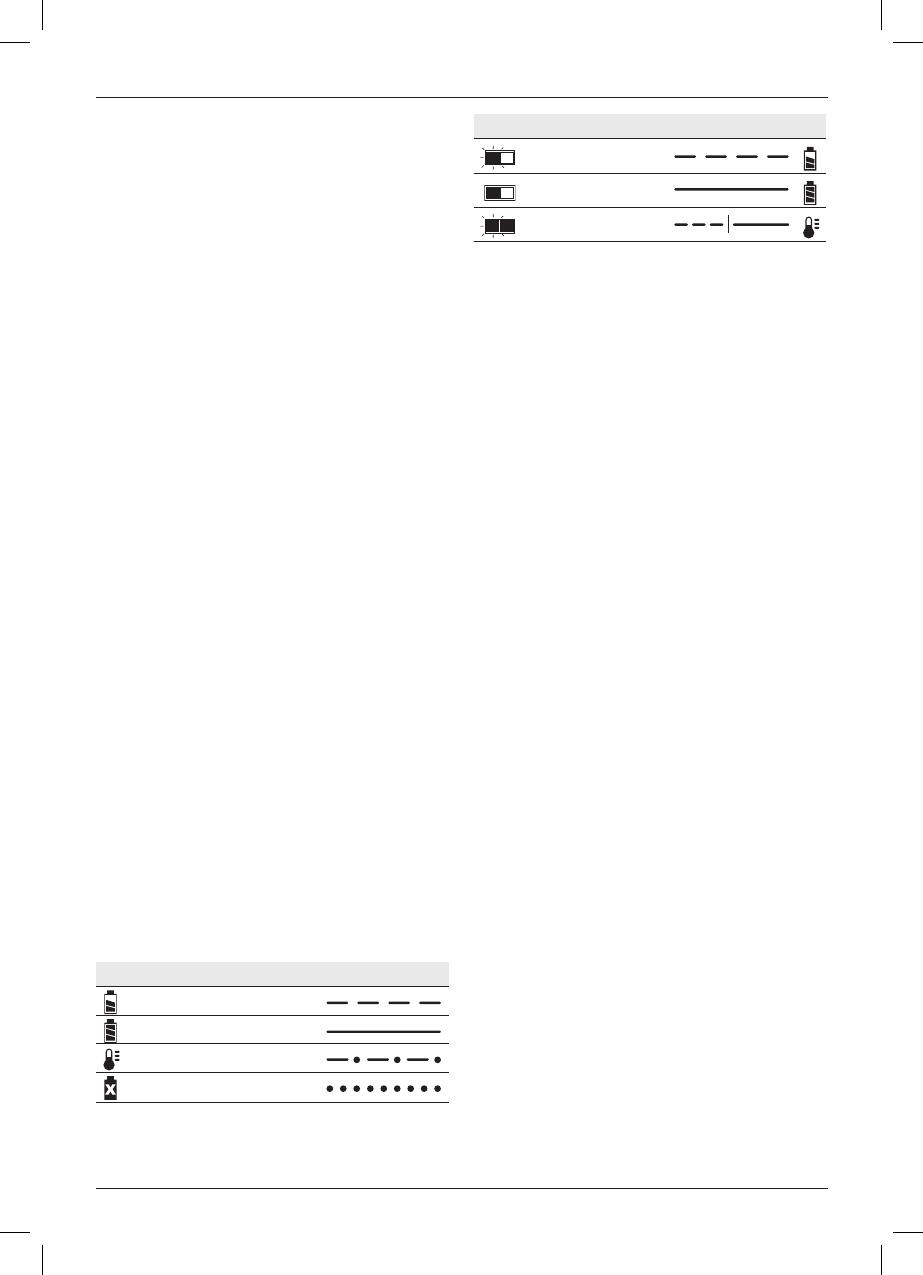
29
english
Charge indicators: DCB107, DCB112, DCB113, DCB115
charging
fully charged
hot/cold pack delay*
* DCB107, DCB112, DCB113, DCB115: The red
light will continue to blink, but a yellow indicator
light will be illuminated during this operation.
Once the battery has reached an appropriate
temperature, the yellow light will turn off and the
charger will resume the chargingprocedure.
The compatible charger(s) will not charge a faulty
battery pack. The charger will indicate faulty battery
by refusing to light or by displaying problem pack or
charger blinkpattern.
NOTE: This could also mean a problem with
acharger.
If the charger indicates a problem, take the charger
and battery pack to be tested at an authorised
servicecentre.
HOT/COLD PACK DELAY
When the charger detects a battery that is too hot
or too cold, it automatically starts a Hot/Cold Pack
Delay, suspending charging until the battery has
reached an appropriate temperature. The charger
then automatically switches to the pack charging
mode. This feature ensures maximum batterylife.
A cold battery pack will charge at about half the
rate of a warm battery pack. The battery pack will
charge at that slower rate throughout the entire
charging cycle and will not return to maximum
charge rate even if the batterywarms.
LITHIUM-ION BATTERY PACKS ONLY
XR Li-Ion tools are designed with an Electronic
Protection System that will protect the battery
against overloading, overheating or deepdischarge.
The tool will automatically turn off if the Electronic
Protection System engages. If this occurs, place
the lithium-ion battery on the charger until it is
fullycharged.
Important Safety Instructions for All
Battery Packs
When ordering replacement battery packs, be sure
to include catalog number andvoltage.
The battery pack is not fully charged out of the
carton. Before using the battery pack and charger,
read the safety instructions below. Then follow
charging proceduresoutlined.
READ ALL INSTRUCTIONS
the manufacturer, its service agent or similar
qualified person to prevent anyhazard.
• Disconnect the charger from the outlet
before attempting any cleaning. This will
reduce the risk of electric shock. Removing
the battery pack will not reduce thisrisk.
• NEVER attempt to connect two
chargerstogether.
• The charger is designed to operate on
standard 230V household electrical
power. Do not attempt to use it on any
other voltage. This does not apply to the
vehicularcharger.
SAVE THESE INSTRUCTIONS
Chargers
The DCB105, DCB107, DCB112, DCB113 and
DCB115 chargers accept 18V Li-Ion XR (DCB140,
DCB141, DCB142, DCB143, DCB144, DCB145,
DCB180, DCB181, DCB182, DCB183, DCB183B,
DCB184, DCB184B and DCB185) batterypacks.
DeWALT
chargers require no adjustment and are
designed to be as easy as possible tooperate.
Charging Procedure (Fig. 2)
1. Plug the charger into an appropriate outlet
before inserting batterypack.
2. Insert the battery pack (G) into the charger.
The red (charging) light will blink continuously
indicating that the charging process
hasstarted.
3. The completion of charge will be indicated by
the red light remaining ON continuously. The
pack is fully charged and may be used at this
time or left in thecharger.
NOTE: To ensure maximum performance and life
of lithium-ion batteries, charge the battery pack fully
before firstuse.
Charging Process
Refer to the table below for the charge status of the
batterypack.
Charge indicators: DCB105
charging
fully charged
hot/cold pack delay
replace battery pack
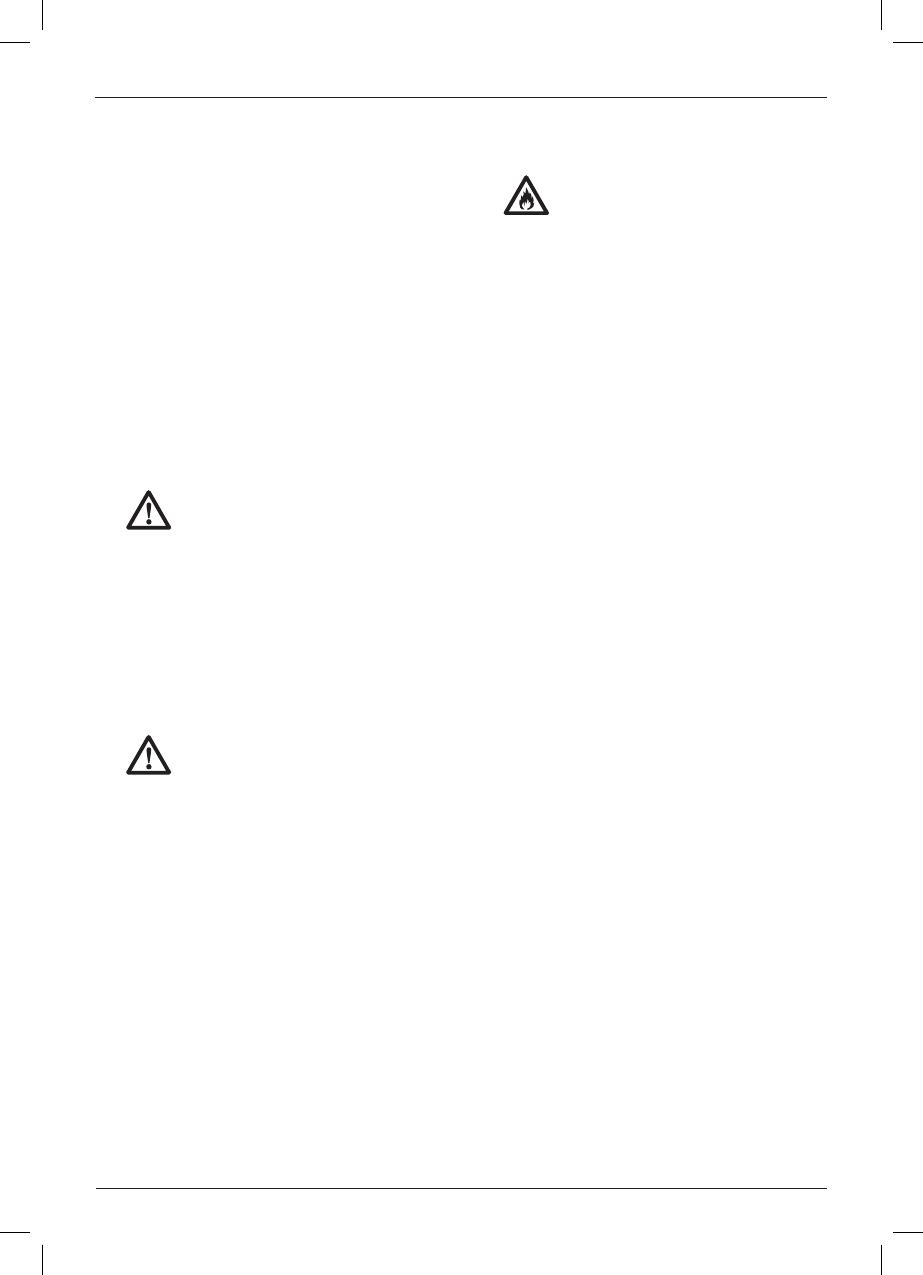
30
english
• Contents of opened battery cells may
cause respiratory irritation. Provide fresh air.
If symptoms persists, seek medicalattention.
WARNING: Burn hazard. Battery liquid
may be flammable if exposed to spark
orflame.
Transportation
DeWALT
batteries comply with all applicable
shipping regulations as prescribed by industry
and legal standards which include UN
Recommendations on the Transport of Dangerous
Goods; International Air Transport Association
(IATA) Dangerous Goods Regulations, International
Maritime Dangerous Goods (IMDG) Regulations,
and the European Agreement Concerning The
International Carriage of Dangerous Goods by Road
(ADR). Lithium-ion cells and batteries have been
tested to section 38.3 of the UN Recommendations
on the Transport of Dangerous Goods Manual of
Tests andCriteria.
In most instances, shipping a
DeWALT
battery pack
will be excepted from being classified as a fully
regulated Class 9 Hazardous Material. In general,
the two instances that require shipping Class 9 are:
1. Air shipping more than two
DeWALT
lithium-ion
battery packs when the package contains only
battery packs (no tools), and
2. Any shipment containing a lithium-ion battery
with an energy rating greater than 100 watt
hours (Wh). All lithium-ion batteries have the
watt hour rating marked on thepack.
Regardless of whether a shipment is
considered excepted or fully regulated, it is the
shipper's responsibility to consult the latest
regulations for packaging, labeling/marking and
documentationrequirements.
Transporting batteries can possibly cause fire if the
battery terminals inadvertently come in contact with
conductive materials. When transporting batteries,
make sure that the battery terminals are protected
and well insulated from materials that could contact
them and cause a shortcircuit.
The information provided in this section of the
manual is provided in good faith and believed to be
accurate at the time the document was created.
However, no warranty, expressed or implied, is
given. It is the buyer’s responsibility to ensure that its
activities comply with the applicableregulations.
• Do not charge or use battery in explosive
atmospheres, such as in the presence of
flammable liquids, gases or dust. Inserting
or removing the battery from the charger may
ignite the dust orfumes.
• Never force battery pack into charger.
Do not modify battery pack in any way
to fit into a non-compatible charger as
battery pack may rupture causing serious
personalinjury.
• Charge the battery packs only in
DeWALT
chargers.
• DO NOT splash or immerse in water or
otherliquids.
• Do not store or use the tool and battery
pack in locations where the temperature
may reach or exceed 40 ˚C (such as
outside sheds or metal buildings in
summer).
WARNING: Never attempt to open the
battery pack for any reason. If battery
pack case is cracked or damaged,
do not insert into charger. Do not
crush, drop or damage battery pack.
Do not use a battery pack or charger
that has received a sharp blow, been
dropped, run over or damaged in any
way (i.e., pierced with a nail, hit with a
hammer, stepped on). Electric shock
or electrocution may result. Damaged
battery packs should be returned to
service centre forrecycling.
CAUTION: When not in use, place
tool on its side on a stable surface
where it will not cause a tripping
or falling hazard. Some tools with
large battery packs will stand upright
on the battery pack but may be easily
knockedover.
SPECIFIC SAFETY INSTRUCTIONS FOR LITHIUM-ION
(LI-ION)
• Do not incinerate the battery pack even
if it is severely damaged or is completely
worn out. The battery pack can explode in
a fire. Toxic fumes and materials are created
when lithium-ion battery packs areburned.
• If battery contents come into contact with
the skin, immediately wash area with mild
soap and water. If battery liquid gets into the
eye, rinse water over the open eye for
15 minutes or until irritation ceases. If medical
attention is needed, the battery electrolyte
is composed of a mixture of liquid organic
carbonates and lithiumsalts.
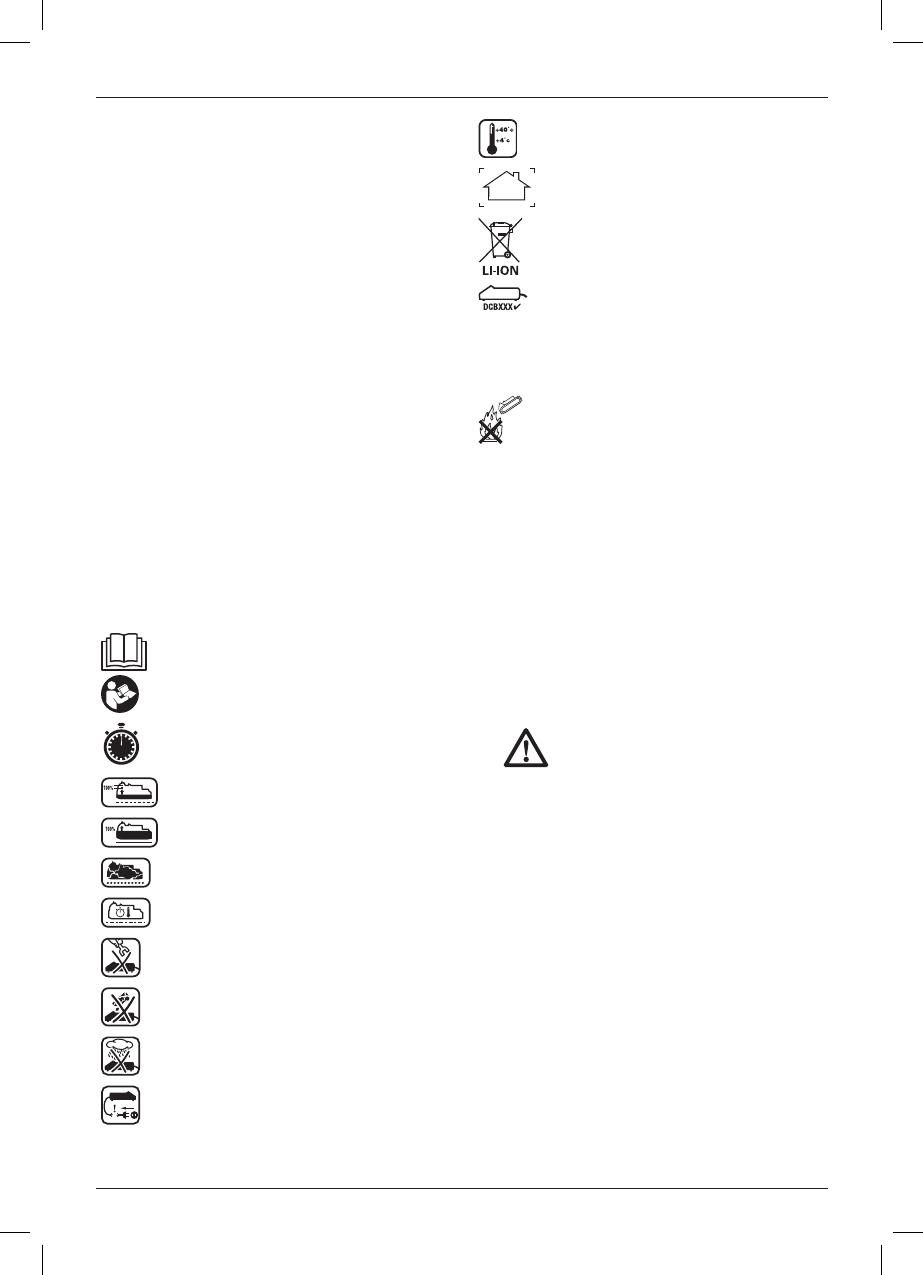
31
english
Charge only between 4 ˚C and 40 ˚C.
Only for indooruse.
Discard the battery pack with due care
for theenvironment.
Charge
DeWALT
battery packs only with
designated
DeWALT
chargers. Charging
battery packs other than the designated
DeWALT
batteries with a
DeWALT
charger may make them burst or lead to
other dangeroussituations.
Do not incinerate the batterypack.
Package Contents
The package contains:
1 Vacuum cleaner
1 Hose
1 Instruction manual
• Check for damage to the tool, parts or
accessories which may have occurred
duringtransport.
• Take the time to thoroughly read and
understand this manual prior tooperation.
Description (Fig. 1)
WARNING: Never modify the power
tool or any part of it. Damage or personal
injury couldresult.
A. On/off switch
B. Hose nozzle
C. Vacuum nozzle
D. Hose connector
E. Tank inlet (Fig. 2)
E. Rear latch
F. Tank
G. Battery pack
H. Battery release button
INTENDED USE
Your DCV517 cordless vacuum cleaner has been
designed to vacuum dry and wet substances in
professionalapplications.
This vacuum cleaner is a professional powertools.
DO NOT use to vacuumliquids.
Battery Pack
BATTERY TYPE
The DCV517 operates on an 18 volt batterypack.
The DCB180, DCB181, DCB182, DCB183,
DCB183B, DCB184, DCB184B or DCB185 battery
packs may be used. Refer to Technical Data for
moreinformation.
Storage Recommendations
1. The best storage place is one that is cool and
dry away from direct sunlight and excess heat
or cold. For optimum battery performance and
life, store battery packs at room temperature
when not inuse.
2. For long storage, it is recommended to store a
fully charged battery pack in a cool, dry place
out of the charger for optimalresults.
NOTE: Battery packs should not be stored
completely depleted of charge. The battery pack will
need to be recharged beforeuse.
Labels on Charger and Battery Pack
In addition to the pictographs used in this manual,
the labels on the charger and the battery pack may
show the following pictographs:
Read instruction manual beforeuse.
See Technical Data for chargingtime.
Batterycharging.
Batterycharged.
Batterydefective.
Hot/cold packdelay.
Do not probe with conductiveobjects.
Do not charge damaged batterypacks.
Do not expose to water.
Have defective cords
replacedimmediately.

32
english
Inserting and Removing the
Battery Pack from the Tool (Fig. 2)
NOTE: Make sure your battery pack (G) is
fullycharged.
TO INSTALL THE BATTERY PACK INTO THE TOOL HANDLE
1. Align the battery pack (G) with the rails on the
underside of the tool (Fig. 2).
2. Slide it into the unit until the battery pack is
firmly seated and ensure that you hear the lock
snap intoplace.
TO REMOVE THE BATTERY PACK FROM THE TOOL
1. Press the release button (H) and firmly pull the
battery pack out of thetool.
2. Insert battery pack into the charger as
described in the charger section of thismanual.
FUEL GAUGE BATTERY PACKS (FIG. 2)
Some
DeWALT
battery packs include a fuel
gauge which consists of three green LED lights
that indicate the level of charge remaining in the
batterypack.
To actuate the fuel gauge, press and hold the fuel
gauge button (X). A combination of the three green
LED lights will illuminate designating the level of
charge left. When the level of charge in the battery
is below the usable limit, the fuel gauge will not
illuminate and the battery will need to berecharged.
NOTE: The fuel gauge is only an indication of the
charge left on the battery pack. It does not indicate
tool functionality and is subject to variation based
on product components, temperature and end-
userapplication.
Removing and Refitting the Hose
(Fig. 3)
REMOVING
1. Take the hose nozzle (B) out of the fitting (C).
2. Turn the connecting piece (D) anti-clockwise.
3. Pull the hose off the vacuum inlet (E) at the
connectingpiece.
REFITTING
1. Insert the hose connector (D) into the tank
inlet (E) taking care to align the tabs on
the connector with the notches in the tank
inlethole.
2. Turn the connecting piece clockwise to fix the
hose itposition.
3. Insert the hose nozzle (B) into the vacuum
nozzle (C).
NOTE: This appliance is suited for the commercial
use, e.g. in hotels, schools, hospitals, factories,
shops, offices, rental companies, and on
constructionsites.
Electrical Safety
The electric motor has been designed for one
voltage only. Always check that the battery pack
voltage corresponds to the voltage on the rating
plate. Also make sure that the voltage of your
charger corresponds to that of yourmains.
Your
DeWALT
charger is double insulated
in accordance with EN60335; therefore no
earth wire isrequired.
If the supply cord is damaged, it must be replaced
by a specially prepared cord available through the
DeWALT
serviceorganisation.
Mains Plug Replacement
(U.K. & Ireland Only)
If a new mains plug needs to be fitted:
• Safely dispose of the oldplug.
• Connect the brown lead to the live terminal in
theplug.
• Connect the blue lead to the neutralterminal.
WARNING: No connection is to be
made to the earthterminal.
Follow the fitting instructions supplied with good
quality plugs. Recommended fuse: 3A.
Using an Extension Cable
An extension cord should not be used unless
absolutely necessary. Use an approved extension
cable suitable for the power input of your charger
(see Technical Data). The minimum conductor size
is 1 mm
2
; the maximum length is 30m.
When using a cable reel, always unwind the
cablecompletely.
ASSEMBLY AND ADJUSTMENTS
WARNING: To reduce the risk of
serious personal injury, turn tool
off and disconnect battery pack
before making any adjustments or
removing/installing attachments or
accessories. An accidental start-up can
causeinjury.
WARNING: Use only
DeWALT
battery
packs andchargers.
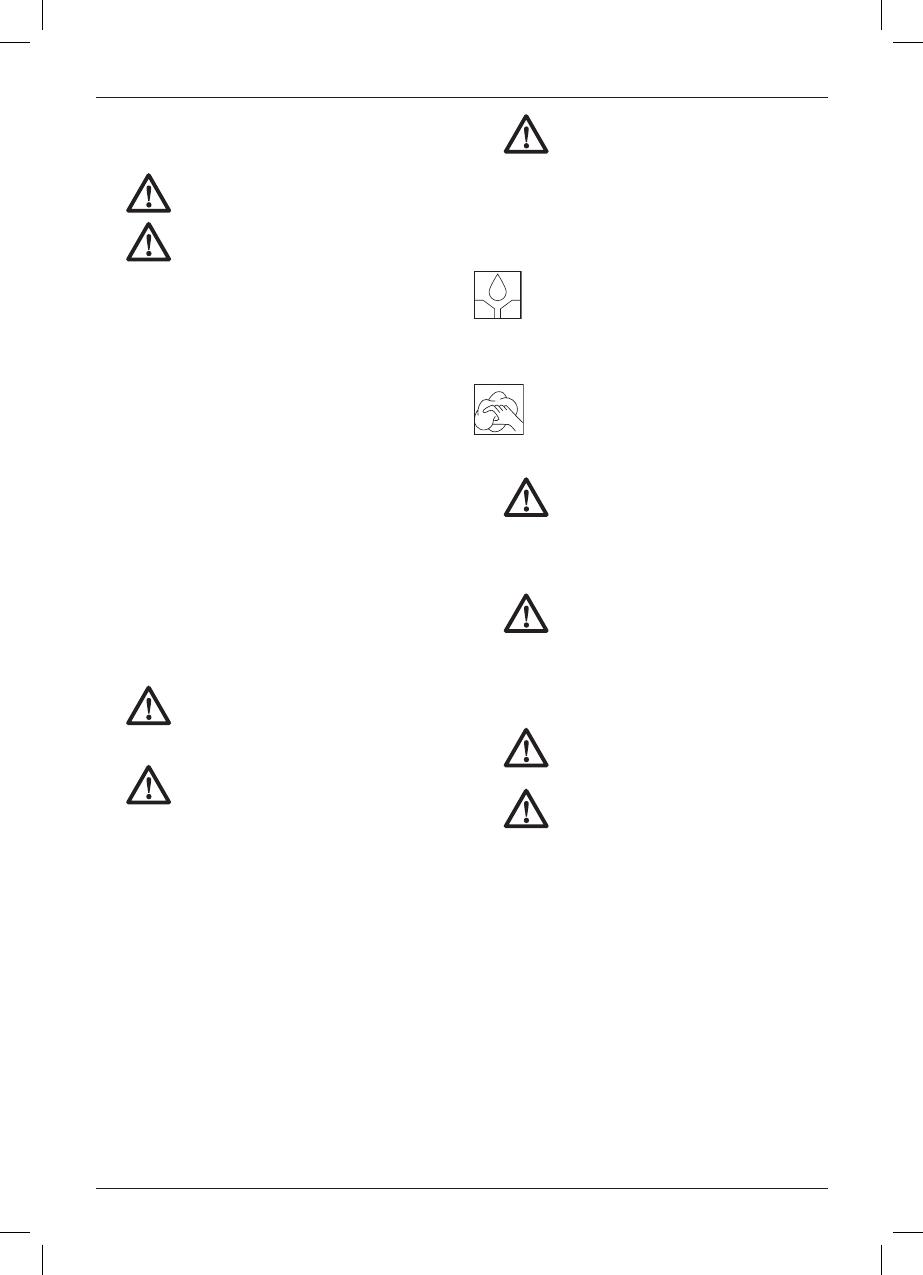
33
english
WARNING: To reduce the risk of
serious personal injury, turn tool
off and disconnect battery pack
before making any adjustments or
removing/installing attachments or
accessories. An accidental start-up can
causeinjury.
The charger and battery pack are notserviceable.
Lubrication
Your power tool requires no additionallubrication.
Cleaning
WARNING: Blow dirt and dust out of
the main housing with dry air as often as
dirt is seen collecting in and around the
air vents. Wear approved eye protection
and approved dust mask when
performing thisprocedure.
WARNING: Never use solvents or
other harsh chemicals for cleaning the
non-metallic parts of the tool. These
chemicals may weaken the materials
used in these parts. Use a cloth
dampened only with water and mild
soap.
WARNING: Do not wash the inside of
the filter. Let the filter dry thoroughly if the
inside becomeswet.
WARNING: Do not use a brush to clean
thefilter.
CLEANING THE TANK (FIG. 4)
The tank should be cleaned after each use or when
switching substances duringuse.
1. Empty the tank (F).
2. Clean the tank using mild soap and a damp
cloth.
3. Dry the tank carefully using a softcloth.
CLEANING THE DUST FILTER (FIG. 5)
The dust filter should be cleaned after each use. If
the filter is damaged or fails to operate properly, it
must bereplaced.
1. Remove the dust filter (I) by turning it anti-
clockwise and taking it off the suctionopening.
2. Shake off excess dust by tapping the filter into
a wastecontainer.
OPERATION
Instructions for Use
WARNING: Always observe the safety
instructions and applicableregulations.
WARNING: To reduce the risk of
serious personal injury, turn tool
off and disconnect battery pack
before making any adjustments or
removing/installing attachments or
accessories. An accidental start-up can
causeinjury.
Switching on and off (fig. 1)
• To switch the tool on, set the on/off switch (A)
to positionI.
• To switch the tool off, set the on/off switch (A)
to positionO.
Vacuuming (fig. 1)
• Empty and clean the tank (F) beforeuse.
• Ensure the hose is mountedcorrectly.
• Move the vacuum nozzle (C) over the surface
to be cleaned. If necessary, the hose nozzle (B)
can be utilized for confinedspaces.
NOTE: It is recommended not mixing wet and dry
substances. When switching substances, empty
and clean the tankfirst.
WARNING: Always use the tool in
upright position. Do not tilt the tool to
prevent liquids collected in the tank from
entering the motorhousing.
WARNING: Always operate the tool with
the dust filter inplace.
Emptying the tank (fig. 4)
The tank must be emptied when the suction power
reducessignificantly.
1. Release the latch (E) and remove the tank (F).
2. Empty the contents of the tank with due care
for theenvironment.
3. Clean the filter (I). Refer toCleaning.
4. Clean if necessary the tank (F) and reinstall,
securing thelatch.
MAINTENANCE
Your
DeWALT
power tool has been designed
to operate over a long period of time with a
minimum of maintenance. Continuous satisfactory
operation depends upon proper tool care and
regularcleaning.
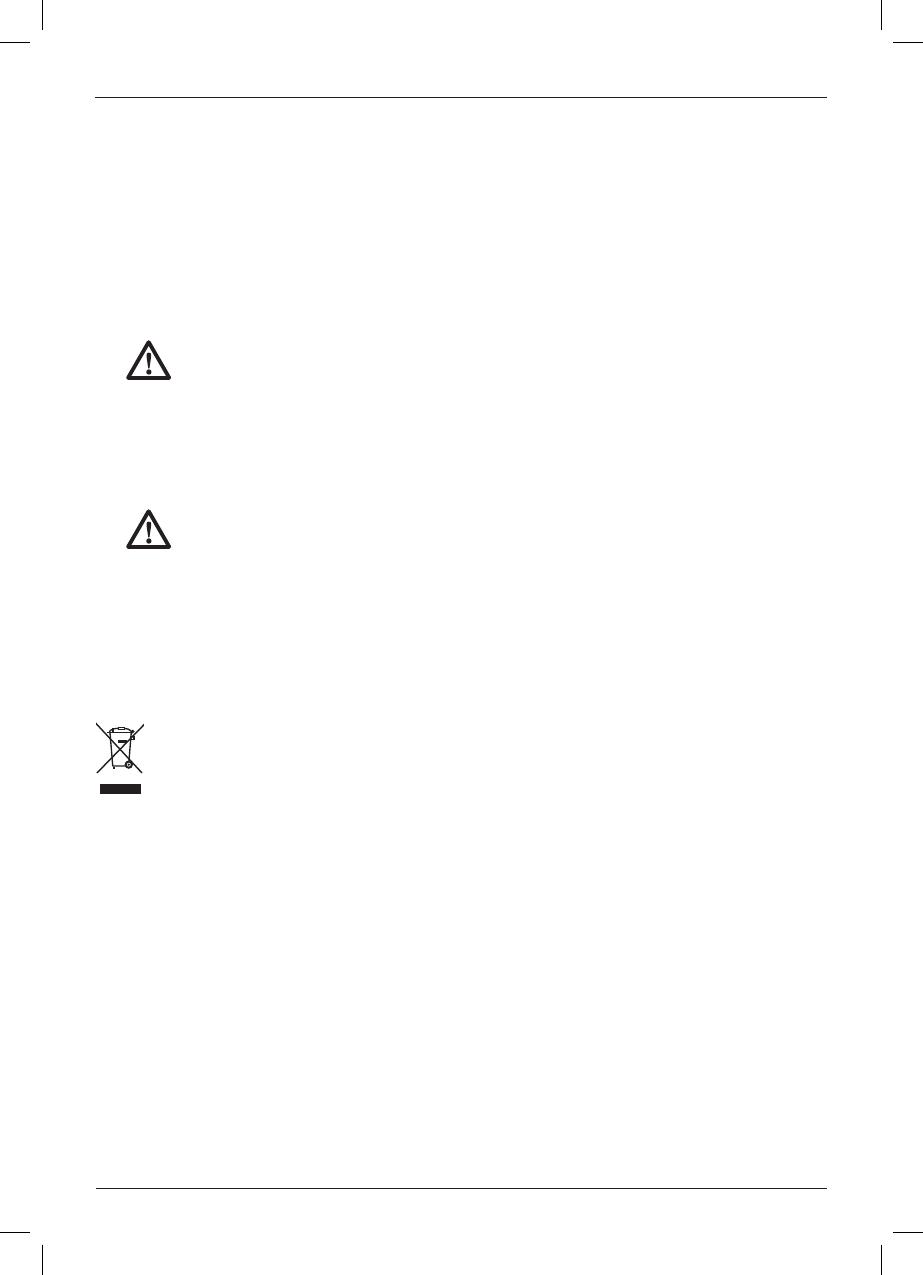
34
english
3. Depending on its condition, rinse the outside of
the filter under lukewarm running water. Dry the
filter before putting it back inplace.
4. Secure the filter by placing it over the suction
opening and turning itclockwise.
CLEANING THE SUCTION OPENING FILTER (FIG. 5)
1. Remove the filter (J) from the suctionopening.
2. Rinse the filter under lukewarm runningwater.
3. Dry the filter before putting it back inplace.
CHARGER CLEANING INSTRUCTIONS
WARNING: Shock hazard. Disconnect
the charger from the AC outlet before
cleaning. Dirt and grease may be
removed from the exterior of the
charger using a cloth or soft non-
metallic brush. Do not use water or any
cleaningsolutions.
Optional Accessories
WARNING: Since accessories, other
than those offered by
DeWALT
, have not
been tested with this product, use of
such accessories with this tool could be
hazardous. To reduce the risk of injury,
only
DeWALT
recommended accessories
should be used with thisproduct.
Consult your dealer for further information on the
appropriateaccessories.
Protecting the Environment
Separate collection. Products and
batteries marked with this symbol
must not be disposed of with normal
householdwaste.
Products and batteries contain materials that can
be recovered or recycled reducing the demand for
raw materials. Please recycle electrical products
and batteries according to local provisions. Further
information is available at www.2helpU.com.
Rechargeable Battery Pack
This long life battery pack must be recharged when
it fails to produce sufficient power on jobs which
were easily done before. At the end of its technical
life, discard it with due care for our environment:
• Run the battery pack down completely, then
remove it from thetool.
• Lithium-ion cells are recyclable. Take them to
your dealer or a local recycling station. The
collected battery packs will be recycled or
disposed ofproperly.

Belgique et
Luxembourg België
en Luxemburg
DeWALT - Belgium BVBA
Egide Walschaertsstraat 16
2800 Mechelen
Tel: NL 32 15 47 37 63
Tel: FR 32 15 47 37 64
Fax: 32 15 47 37 99
www.dewalt.be
enduser[email protected]
Danmark DeWALT
Roskildevej 22
2620 Albertslund
Tel: 70 20 15 10
Fax: 70 22 49 10
www.dewalt.dk
Deutschland DeWALT
Richard Klinger Str. 11
65510 Idstein
Tel: 06126-21-1
Fax: 06126-21-2770
www.dewalt.de
Ελλάς DeWALT (Ελλάς) Α.Ε.
EΔΡΑ-ΓΡΑΦΕΙΑ : Στράβωνος 7
& Λ. Βουλιαγμένης, Γλυφάδα 166 74, Αθήνα
SERVICE : Ημερος Τόπος 2 (Χάνι Αδάμ) – 193 00
Ασπρόπυργος
Τηλ: 00302108981616
Φαξ: 00302108983570
www.dewalt.gr
España DeWALT Ibérica, S.C.A.
Parc de Negocios “Mas Blau”
Edificio Muntadas, c/Bergadá, 1, Of. A6
08820 El Prat de Llobregat (Barcelona)
Tel: 934 797 400
Fax: 934 797 419
www.dewalt.es
France DeWALT
5, allée des Hêtres
BP 30084, 69579 Limonest Cedex
Tel: 04 72 20 39 20
Fax: 04 72 20 39 00
www.dewalt.fr
Schweiz
Suisse
Svizzera
DeWALT
In der Luberzen 42
8902 Urdorf
Tel: 044 - 755 60 70
Fax: 044 - 730 70 67
www.dewalt.ch
Ireland DeWALT
Calpe House Rock Hill
Black Rock, Co. Dublin
Tel: 00353-2781800
Fax: 00353-2781811
www.dewalt.ie
Italia DeWALT
via Energypark
20871 Vimercate (MB), IT
Tel: 800-014353
39 039 9590200
Fax: 39 039 9590313
www.dewalt.it
Nederlands DeWALT Netherlands BV
Holtum Noordweg 35
6121 RE BORN, Postbus 83, 6120 AB BORN
Tel: 31 164 283 063
Fax: 31 164 283 200
www.dewalt.nl
Norge DeWALT
Postboks 4613, Nydalen
0405 Oslo
Tel: 45 25 13 00
Fax: 45 25 08 00
www.dewalt.no
Österreich DeWALT
Werkzeug Vertriebsges m.b.H
Oberlaaerstrasse 248, A-1230 Wien
Tel: 01 - 66116 - 0
Fax: 01 - 66116 - 614
www.dewalt.at
Portugal DeWALT Limited, SARL
Centro de Escritórios de Sintra Avenida
Almirante Gago Coutinho, 132/134, Edifício 14
2710-418 Sintra
Tel: 214 66 75 00
Fax: 214 66 75 80
www.dewalt.pt
Suomi DeWALT
PL 47
00521 Helsinki
Puh: 010 400 4333
Faksi: 0800 411 340
www.dewalt.fi
Sverige DeWALT
Box 94
431 22 Mölndal
Tel: 031 68 61 60
Fax: 031 68 60 08
www.dewalt.se
Türkiye KALE Hırdavat ve Makina A.Ş.
Defterdar Mah. Savaklar Cad. No:15
Edirnekapı / Eyüp / İSTANBUL 34050 TÜRKİYE
Tel: 0212 533 52 55
Faks: 0212 533 10 05
www.dewalt.com.tr
United
Kingdom
DeWALT, 210 Bath Road;
Slough, Berks SL1 3YD
Tel: 01753-567055
Fax: 01753-572112
www.dewalt.co.uk
Australia DeWALT
82 Taryn Drive, Epping
VIC 3076 Australia
Tel: Aust 1800 338 002
Tel: NZ 0800 339 258
www.dewalt.com.au
www.dewalt.co.nz
Middle East Africa DeWALT
P.O. Box - 17164,
Jebel Ali Free Zone (South), Dubai, UAE
Tel: 971 4 812 7400
Fax: 971 4 2822765
www.dewalt.ae
N450071
11/15
/